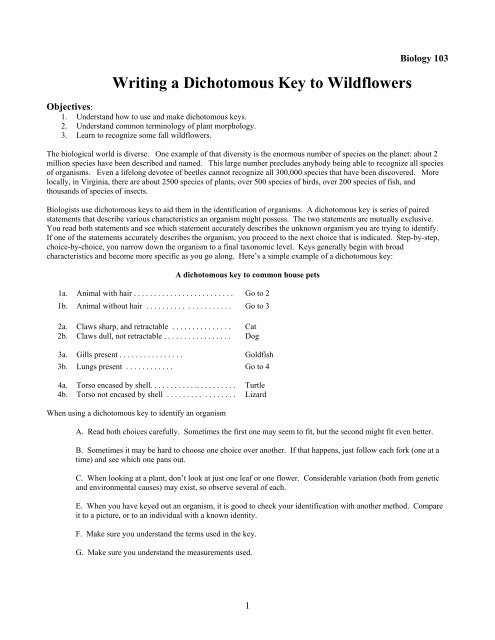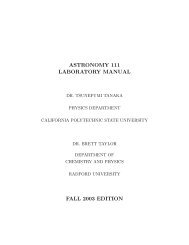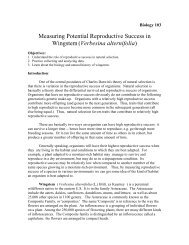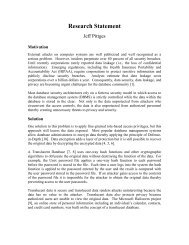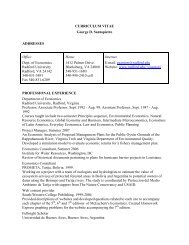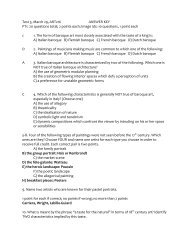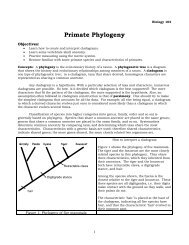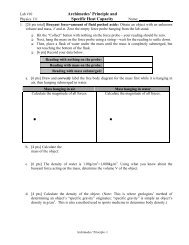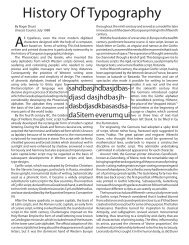Writing a Dichotomous Key to Wildflowers
Writing a Dichotomous Key to Wildflowers
Writing a Dichotomous Key to Wildflowers
Create successful ePaper yourself
Turn your PDF publications into a flip-book with our unique Google optimized e-Paper software.
<strong>Writing</strong> a <strong>Dicho<strong>to</strong>mous</strong> <strong>Key</strong> <strong>to</strong> <strong>Wildflowers</strong><br />
Objectives:<br />
1. Understand how <strong>to</strong> use and make dicho<strong>to</strong>mous keys.<br />
2. Understand common terminology of plant morphology.<br />
3. Learn <strong>to</strong> recognize some fall wildflowers.<br />
Biology 103<br />
The biological world is diverse. One example of that diversity is the enormous number of species on the planet: about 2<br />
million species have been described and named. This large number precludes anybody being able <strong>to</strong> recognize all species<br />
of organisms. Even a lifelong devotee of beetles cannot recognize all 300,000 species that have been discovered. More<br />
locally, in Virginia, there are about 2500 species of plants, over 500 species of birds, over 200 species of fish, and<br />
thousands of species of insects.<br />
Biologists use dicho<strong>to</strong>mous keys <strong>to</strong> aid them in the identification of organisms. A dicho<strong>to</strong>mous key is series of paired<br />
statements that describe various characteristics an organism might possess. The two statements are mutually exclusive.<br />
You read both statements and see which statement accurately describes the unknown organism you are trying <strong>to</strong> identify.<br />
If one of the statements accurately describes the organism, you proceed <strong>to</strong> the next choice that is indicated. Step-by-step,<br />
choice-by-choice, you narrow down the organism <strong>to</strong> a final taxonomic level. <strong>Key</strong>s generally begin with broad<br />
characteristics and become more specific as you go along. Here’s a simple example of a dicho<strong>to</strong>mous key:<br />
A dicho<strong>to</strong>mous key <strong>to</strong> common house pets<br />
1a. Animal with hair . . . . . . . . . . . . . . . . . . . . . . . . . Go <strong>to</strong> 2<br />
1b. Animal without hair . . . . . . . . . . . . . . . . . . . . . Go <strong>to</strong> 3<br />
2a. Claws sharp, and retractable . . . . . . . . . . . . . . . Cat<br />
2b. Claws dull, not retractable . . . . . . . . . . . . . . . . . Dog<br />
3a. Gills present . . . . . . . . . . . . . . . . Goldfish<br />
3b. Lungs present . . . . . . . . . . . . Go <strong>to</strong> 4<br />
4a. Torso encased by shell. . . . . . . . . . . .. . . . . . . . . . Turtle<br />
4b. Torso not encased by shell . . . . . . . . . . . . . . . . . Lizard<br />
When using a dicho<strong>to</strong>mous key <strong>to</strong> identify an organism<br />
A. Read both choices carefully. Sometimes the first one may seem <strong>to</strong> fit, but the second might fit even better.<br />
B. Sometimes it may be hard <strong>to</strong> choose one choice over another. If that happens, just follow each fork (one at a<br />
time) and see which one pans out.<br />
C. When looking at a plant, don’t look at just one leaf or one flower. Considerable variation (both from genetic<br />
and environmental causes) may exist, so observe several of each.<br />
E. When you have keyed out an organism, it is good <strong>to</strong> check your identification with another method. Compare<br />
it <strong>to</strong> a picture, or <strong>to</strong> an individual with a known identity.<br />
F. Make sure you understand the terms used in the key.<br />
G. Make sure you understand the measurements used.<br />
1
Methods:<br />
Assignment 1: To ensure you understand the format and principle of dicho<strong>to</strong>mous keys, it might be helpful <strong>to</strong> write a short<br />
key <strong>to</strong> something familiar. For example, you could write a key <strong>to</strong> the following snacks: cupcake, chocolate candy bar, taco<br />
chips, pota<strong>to</strong> chips, and pretzels. Or you could write a key <strong>to</strong> several of the people in your lab section. Your instruc<strong>to</strong>r<br />
may have other suggestions.<br />
Here are some guidelines for writing dicho<strong>to</strong>mous keys.<br />
1. Start with the most general characteristics and progress <strong>to</strong> increasingly more specific characteristics.<br />
2. Leave a space between each pair of choices <strong>to</strong> make the key easier <strong>to</strong> read.<br />
3. Make the key dicho<strong>to</strong>mous. That is, you should have two, and only two, choices (a couplet) at each number. Number<br />
the two statements of each couplet with the same number. For example, a key <strong>to</strong> the phyla of plants might begin:<br />
1. Seeds present (2)<br />
1. Seeds absent (3)<br />
4. Words like “long” or “short” or “many” or “few" or “narrow” or “wide” are vague; don’t use them. Instead use actual<br />
measurements like:<br />
1. Leaves longer than 5 cm<br />
1. Leaves shorter than 4 cm<br />
5. The two choices in a couplet should be mutually exclusive and should begin with identical words. To be mutually<br />
exclusive they need <strong>to</strong> refer <strong>to</strong> different qualities of the same character. The two choices shown at #4 above cannot both<br />
apply <strong>to</strong> the same plant, thus they are mutually exclusive.<br />
6. Don’t use overlapping descriptions like this:<br />
1. Legs 6 or fewer (2)<br />
1. Legs 4 or more (6)<br />
If someone was trying <strong>to</strong> key out an organism with 5 legs, he/she wouldn’t know whether <strong>to</strong> go <strong>to</strong> 2 or 6.<br />
7. Start descriptions with a subject.<br />
5. Flowers with 5 petals<br />
5. Flowers with 6 petals<br />
NOT:<br />
NOT:<br />
5. Five petals per flower<br />
5. Six petals per flower<br />
8. Don’t use more words than you must:<br />
Plants with flowers that have 5 petals<br />
Plants with flowers that have 6 petals<br />
The same information can be said more briefly, as in #7 above.<br />
Assignment 2: Write a key <strong>to</strong> several species of wildflowers.<br />
First, you need <strong>to</strong> know some characteristics of each plant. Some of the terminology used <strong>to</strong> describe flowering<br />
plants is shown in a glossary at the end of this lab. Once you have become familiar with some of these terms, choose<br />
several wildflowers and fill out the character table (Table 1). You may find some of these characters helpful in<br />
constructing your key. Depending on what flowers you use, some of the characters might not be used. Some space has<br />
been left for you <strong>to</strong> add characters you think might be helpful. Characteristics that are most valuable are ones that don’t<br />
vary within a species, but that do vary between species.<br />
After filling in the data table, you can start constructing your key. Group plants <strong>to</strong>gether that share several similar<br />
characteristics. Pick a characteristic that gives you a couple of subgroups. Use this characteristic <strong>to</strong> write you first pair of<br />
statements and start your key. Start with a general characteristic, and move <strong>to</strong> more specific ones. For each subgroup,<br />
determine how <strong>to</strong> break them further in<strong>to</strong> smaller subgroups.<br />
2
Table 1: Characters of fall wildflowers<br />
Taxon<br />
Characters<br />
Plant herbaceous or woody<br />
Plant upright, decumbent, or<br />
climbing vine<br />
leaf venation:<br />
parallel or net<br />
Leaf length<br />
Leaf width<br />
Leaf<br />
length/width ratio<br />
Petiole: present/absent<br />
Leaves:<br />
simple or compound<br />
Leaves: opposite or<br />
alternate or whorled<br />
Flower color<br />
Petal length<br />
Petals:<br />
fused or free<br />
# of petals<br />
# of sepals<br />
3
Table 2: A glossary of terms used in Table 1<br />
Plant herbaceous or woody<br />
Plant upright, decumbent, or<br />
climbing vine<br />
leaf venation:<br />
parallel or net<br />
Petiole: present/absent<br />
Leaves:<br />
simple or compound<br />
Leaves: opposite or<br />
alternate or whorled<br />
sepals<br />
petals<br />
Petals fused or free<br />
Herbaceous - green and flexible throughout, not woody<br />
Woody – stems and older twigs are stiff<br />
Decumbent – stems lying on ground, only the tips are upright<br />
If vine is climbing, note whether it climbs using tendrils, roots, or by twining itself<br />
around other stems. Tendrils are leaves that are modified for grasping.<br />
Veins made up of vascular tissue are visible in the surface of a leaf. The veins may<br />
be parallel <strong>to</strong> each other and run the length of the leaf, or they may form a branched<br />
network throughout the leaf.<br />
A petiole is the stalk that attaches the relatively broad, flat portion of the leaf <strong>to</strong> the<br />
stem. The broad portion of the leaf is called the blade. Some leaves lack petioles.<br />
See Figure 2.<br />
A compound leaf has a blade divided in<strong>to</strong> leaflets; a compound leaf may appear <strong>to</strong> be<br />
several leaves. A “3-leaf clover” is actually one leaf with three leaflets. A leaf will<br />
have a bud at its base next <strong>to</strong> the stem, but a leaflet will not.<br />
A node is the spot on a stem from which leaves arise. Leaves are alternate, if there is<br />
1 leaf per node. Leaves are opposite if there are two leaves per node.<br />
See Figures 1 and 2. Leaves are whorled if there are three or more leaves per node.<br />
Flowers may have four whorls of parts. The outermost whorl of parts is made up of<br />
several sepals. On some plants sepals are green, on others they are colorful. See<br />
Figure 3.<br />
Just inside the whorl of sepals, is a whorl of petals. See Figure 3.<br />
Petals are ‘free’ if they appear as 3 or 4 or 5 separate units. In some flowers, the<br />
petals are fused <strong>to</strong> form funnel-like or trumpet-like shapes.<br />
pistil<br />
stamen<br />
petal<br />
sepal<br />
Figure 1: Opposite leaves Figure 2: Alternate leaves Figure 3: Four whorls of a flower<br />
4
1. Once your key is finished, share it with another group, and have them use it <strong>to</strong> key out a plant.<br />
Does the key enable them <strong>to</strong> identify the wildflowers correctly? What problems do they have with it?<br />
Can you improve your key?<br />
3. What is a potential problem in using color as a character?<br />
4. What is a potential problem in using plant height as a character?<br />
5. Characteristics of flowers are often used in keys <strong>to</strong> flowering plants. In light of the biological<br />
species concept and the flower’s role in a plant’s life cycle, why does it make sense <strong>to</strong> have<br />
characteristics of flowers as part of a key?<br />
5


